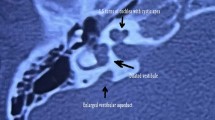Abstract
With the introduction and rapid development of Cochlear Implants since the 1970s, there has been marked improvement in the speech recognition and spoken language skills of the implanted profoundly deaf children. The cochlear implant can be done by means of different techniques, traditionally by Cochleostomy method and round window membrane (RWM) insertion technique. Post operatively, the functional outcomes are measured by many scores more commonly by Categories of Auditory Performance (CAP) and Speech Intelligibility Rating (SIR) scores. To study the speech and hearing perception skills in pediatric cases of Congenital non syndromic bilateral profound sensorineural hearing loss after Cochleostomy and Round Window Insertion technique of Cochlear Implantation. 31 patients clinically diagnosed as congenital non syndromic bilateral profound sensorineural hearing loss who had undergone Cochlear implantation either by Cochleostomy or by RWM insertion technique and fulfilling the eligibility criteria were enrolled for study. Post operatively functional outcomes were assessed subjectively by measuring CAP and SIR scores. All the patients showed increase in their CAP and SIR scores post-operatively, measured at 03 months, 06 months and 01 year after Cochlear Implantation. The mean CAP and SIR scores in the two groups were comparable at 03 months, 06 months and 1 year after surgery. There was no significant difference in the speech and hearing perception skills of post implantees in the two groups (p value < 0.05). There is no difference in functional outcomes of Cochlear implantation by Cochleostomy and round window membrane insertion technique.



Similar content being viewed by others
References
Nikolopoulos TP, O’Donoghue GM, Archbold S (1999) Age at implantation: its importance in pediatric cochlear implantation. The Laryngoscope. 109(4):595–599
Chiossi JSC, Hyppolito MA (2017) Effects of residual hearing on cochlear implant outcomes in children: a systematic-review. Int J Pediatr Otorhinolaryngol 100:119–127
Liu Y, Dong R, Li Y, Xu T, Li Y, Chen X et al (2014) Effect of age at cochlear implantation on auditory and speech development of children with auditory neuropathy spectrum disorder. Auris Nasus Larynx 41(6):502–506
Elkayal VA, Mourad M, Elbanna M, Talaat MM (2016) Evaluation of factors that influence cochlear implant performance. Adv Arab Acad Audio-Vestibulogy J 3(1):1
Amirsalari S, Ajallouyean M, Saburi A, Haddadi Fard A, Abed M, Ghazavi Y (2011) Cochlear implantation outcomes in children with Waardenburg syndrome. Eur Arch Otorhinolaryngol 269:2179–2183
Adunka OF, Dillon MT, Adunka MC, King ER, Pillsbury HC, Buchman CA (2014) Cochleostomy versus round window insertions: influence on functional outcomes in electric-acoustic stimulation of the auditory system. Otol Neurotol Off Publ Am Otol Soc Am Neurotol Soc Eur Acad Otol Neurotol. 35(4):613–618
Zhou H, Chen Z, Shi H, Wu Y, Yin S (2013) Categories of auditory performance and speech intelligibility ratings of early-implanted children without speech training. PLoS ONE. 8(1):e53852
Archbold S, Lutman ME, Nikolopoulos T (1998) Categories of auditory performance: inter-user reliability. Br J Audiol 32(1):7–12
Allen C, Nikolopoulos TP, Dyar D, O’Donoghue GM (2001) Reliability of a rating scale for measuring speech intelligibility after pediatric cochlear implantation. Otol Neurotol Off Publ Am Otol Soc Am Neurotol Soc Eur Acad Otol Neurotol. 22(5):631–633
Archbold SM, Nikolopoulos TP, Lloyd-Richmond H (2009) Long-term use of cochlear implant systems in paediatric recipients and factors contributing to non-use. Cochlear Implants Int. 10(1):25–40
Saravanan DV, Nallasivam DM, Sivakumar DM (2017) Agewise outcome of speech and hearing in prelingually deaf children after cochlear implantation. IOSR J Dent Med Sci. 16(04):69–74
Archbold S, Lutman ME, Marshall DH (1995) Categories of auditory performance. Ann Otol Rhinol Laryngol Suppl 166:312–314
De Raeve L (2010) A longitudinal study on auditory perception and speech intelligibility in deaf children implanted younger than 18 months in comparison to those implanted at later ages. Otol Neurotol. 31(8):1261–1267
Kang BJ, Kim AH (2013) Comparison of cochlear implant performance after round window electrode insertion compared with traditional cochleostomy. Otolaryngol-Head Neck Surg. 148(5):822–826
Author information
Authors and Affiliations
Corresponding author
Ethics declarations
Conflict of interest
The authors declare that they have no conflict of interest.
Ethical Approval
The study was performed after due approval from the institutional ethical committee.
Human and Animal Rights
The article does not contain any studies with animals performed by any of the authors.
Additional information
Publisher's Note
Springer Nature remains neutral with regard to jurisdictional claims in published maps and institutional affiliations.
Rights and permissions
About this article
Cite this article
Rajput, M., Nilakantan, A. Functional Outcomes in Cochleostomy and Round Window Insertion Technique: Difference or No Difference?. Indian J Otolaryngol Head Neck Surg 71 (Suppl 2), 1615–1620 (2019). https://doi.org/10.1007/s12070-019-01688-w
Received:
Accepted:
Published:
Issue Date:
DOI: https://doi.org/10.1007/s12070-019-01688-w




